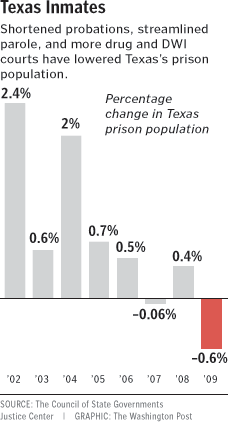Law and Order, or A System Gone Berserk?
The statistics on the number of Americans incarcerated are truly eye catching, especially when compared to other nations.

There are approximately 2.3 million Americans in jail, equivalent to 1 out of every 100 Americans. America has in its jails almost 25% of the entire prison population in the world, yet we represent only 5% of the world’s population. Sentencing for similar crimes in other nations results in much smaller prison sentences.
The increase in jail sentences has skyrocketed since the mid 1970’s when America was more in line with the rest of the world, imprisoning only around 110 people per 100,000. What would be considered a mild crime in another country, such as writing a bad check, results in prison time in the United States.
Jail time for drug use has grown with “get tough” drug policies which have done nothing to discourage rampant drug abuse. A record total of 7.2 million people in 2007 were either in jail, on parole or on probation. Black males in the 20 to 39 age group represented a third of all people incarcerated. Convicted criminals lose the right to vote which further alienates them from society.
Some obvious questions to ask are:
- Does America have an unusually large number of criminals?
- Are the sentencing laws too tough for certain crimes?
- Are the police forces overzealous or selective in enforcing the law?
- Should alternate methods such as counseling and treatment be offered instead of harsh prison sentences?
- Would the huge cost of maintaining a large number of prisons and guards be better spent on cheaper at home monitoring and out of prison rehabilitation services?
The one certain fact is that no other nation on earth comes close to the aggressive policies of imprisonment seen in the US.
Silver Lining?
The current economic downturn is again proving the old saying that there is a bright side to everything. With State budgets under sever stress, many are finally asking if the system can be changed to reduce imprisonment time while still protecting society. Consider the following :
States Seek Less Costly Substitutes for Prison –
Cash-strapped states are increasingly turning to alternative sentencing methods and to streamlined probation and parole as a way to keep low-level offenders out of prison and in their communities.
The alternative sentencing methods have been in limited use for years, often with little funding and less publicity. But recently they have gained in popularity across the country and have attracted interest from lawmakers. The measures include drug courts, which allow low-level drug offenders to avoid prison time through treatment and intense, personal, weekly intervention by a judge, and at least 500 courts for people arrested for driving while intoxicated. Drivers avoid jail by attending regular alcohol-treatment classes and by submitting to random tests.
States have also begun to shorten probation and to reduce the number of people sent to prison for technical violations, such as missing appointments. Some states are also more readily granting parole to prisoners as they become eligible, reversing a trend that kept even parole-eligible inmates locked up longer.
These trends are showing up almost everywhere as a direct response to governors and state legislatures looking with alarm at prison costs eating up increasing shares of their budgets.
But what is striking, experts say, is how some states with reputations for being tough on crime are most rapidly embracing these policies, which might have once been dismissed as the product of liberal think tanks and soft-on-crime leniency.
Texas is a case in point. From 1978 to 2004, the inmate population rose 573 percent and the state’s population increased 67 percent. With hard sentencing laws and some conservative judges, Texas built a “lock ’em up” reputation. The state has more than 155,00 inmates and leads the nation in putting prisoners to death.

The changes, implemented in the 2007 legislative session, included more funding for drug and DWI courts. New rules shortened the average probation time from 10 years to five.
The state also ordered the parole board to raise its parole rate to an earlier number of 31 percent; the proportion of eligible inmates granted parole had slipped to 26 percent.
With those changes in place, prison population growth slowed to a trickle. From January 2007 until December 2008, Texas added 529 inmates to its total, a tenth of what was projected.
A powerful motivator for alternative sentencing is recidivism. For nearly 20 years, national recidivism rates have remained the same, with half of all freed inmates returning to prison within three years. But evidence shows that those who get treatment for drug and alcohol problems have a far lower rate of returning to prison.
There Is A Better Way
Obviously, the US is out of touch with the rest of the world when it comes to imprisoning vast numbers of people. Yes, there is a better way of conducting justice instead of harsh, long prison sentences. Unfortunately, it took a major economic upheaval before the issue could be intelligently addressed. Other States should look at the example of reform in Texas and initiate similar programs.
Speak Your Mind